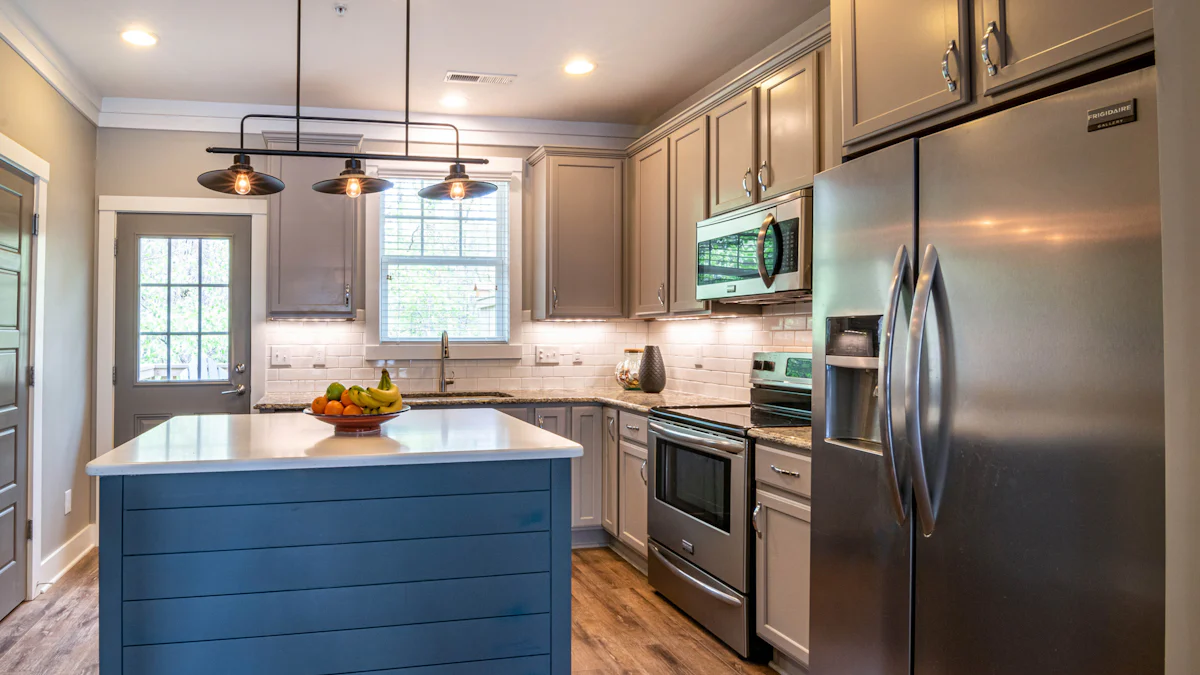Single Induction Cooktops: A Smart Kitchen Upgrade

Imagine transforming your kitchen with a single induction cooktop. This modern marvel offers unmatched efficiency, using up to 90% of the energy produced, compared to only 55% for gas burners. You’ll enjoy faster cooking times, with boiling speeds up to 50% quicker than traditional methods. Safety is paramount, as there’s no open flame or exposed heating element, making it ideal for families. Plus, its sleek design adds a touch of elegance to any kitchen. Upgrade your cooking experience and embrace the future with this smart kitchen solution.
Key Takeaways
Induction cooktops are highly energy-efficient, using up to 90% of the energy produced, which can lead to lower utility bills.
Safety is enhanced with induction cooktops, as they have no open flames and the cooking surface remains cool to the touch, reducing burn risks.
Cleaning is a breeze with induction cooktops due to their smooth surfaces that prevent food from burning on, saving you time and effort.
Induction technology allows for faster cooking times, with boiling speeds up to 50% quicker than traditional methods, making meal prep more efficient.
Switching to an induction cooktop can improve indoor air quality by eliminating harmful pollutants released by gas stoves.
Investing in an induction cooktop may qualify you for local incentives or rebates, helping to offset the initial cost.
Ensure your cookware is compatible with induction cooktops by checking if a magnet sticks to the bottom; if it does, you're good to go!
Benefits of Using a Single Induction Cooktop

Upgrading your kitchen with a single induction cooktop can transform your cooking experience. Let's explore the key benefits that make this appliance a smart choice for any modern kitchen.
Energy Efficiency
A single induction cooktop stands out for its remarkable energy efficiency. Unlike traditional gas or electric cooktops, it uses electromagnetic technology to heat your cookware directly. This means less wasted heat and more energy directed towards cooking your food. You’ll notice quicker cooking times and lower energy bills. By reducing the amount of waste heat, you also lessen the cooling and ventilation needs in your kitchen. This makes an induction cooktop not only efficient but also environmentally friendly.
Safety Features
Safety is a top priority in any kitchen, and a single induction cooktop excels in this area. The cooking surface remains cool to the touch, even during use. This reduces the risk of burns, making it a safer option for households with children or pets. Since there’s no open flame or exposed heating element, you can cook with peace of mind. The cooktop only heats when compatible cookware is placed on it, adding an extra layer of safety. This feature ensures that you can focus on creating delicious meals without worrying about potential hazards.
Ease of Cleaning
Cleaning up after cooking can be a hassle, but a single induction cooktop simplifies this task. Its smooth, flat surface makes wiping away spills and splatters a breeze. Since the cooktop itself doesn’t get hot, food is less likely to burn onto the surface. This means you spend less time scrubbing and more time enjoying your meals. The sleek design not only enhances your kitchen’s aesthetic but also ensures that maintenance is quick and easy.
By choosing a single induction cooktop, you’re investing in an appliance that offers energy efficiency, enhanced safety, and effortless cleaning. These benefits make it a valuable addition to any kitchen, providing you with a modern and convenient cooking solution.
Comparison with Gas and Electric Cooktops
When you consider upgrading your kitchen, understanding how a single induction cooktop compares to gas and electric options is crucial. Each type of cooktop has its own strengths, but induction technology offers unique advantages that might just make it the perfect choice for your home.
Performance and Precision
Induction cooktops excel in performance and precision. Unlike gas cooktops, which rely on an open flame, induction cooktops use electromagnetism to heat your pots and pans directly. This method allows for nearly instantaneous temperature control, giving you the ability to adjust heat levels with remarkable accuracy. You can bring a pot of water to a boil in just 2-3 minutes, which is roughly 20-40% faster than gas or electric cooktops. This speed not only saves you time but also enhances your cooking experience by allowing you to prepare meals more efficiently.
Electric cooktops, while convenient, often lack the responsiveness of induction models. They take longer to heat up and cool down, which can be frustrating when you're trying to achieve precise cooking temperatures. With a single induction cooktop, you get the best of both worlds: the quick response of gas and the easy cleaning of electric surfaces.
Environmental Impact
Choosing an induction cooktop also benefits the environment. Induction technology significantly reduces waste heat, making it three times more energy-efficient than gas cooktops. This efficiency means less energy consumption, which translates to lower utility bills and a smaller carbon footprint. By using an induction cooktop, you contribute to a healthier planet by minimizing emissions associated with traditional gas cooking.
Moreover, induction cooktops help improve indoor air quality. Gas cooktops can release pollutants into your kitchen, affecting the air you breathe. Induction cooktops eliminate this concern, providing a cleaner and safer cooking environment for you and your family.
Cookware Compatibility and Cost Considerations
When you decide to upgrade to a single induction cooktop, understanding cookware compatibility is crucial. Not all pots and pans work with induction technology, so let's dive into what you need to know.
Compatible Cookware
Induction cooktops use electromagnetism to heat your cookware directly. This means your pots and pans must be made of a magnetic material. Induction-compatible cookware includes stainless steel, cast iron, and enameled cast iron. If you already own these types of cookware, you're in luck! You can continue using them without any issues.
To check if your current cookware is compatible, try this simple trick: stick a magnet to the bottom of the pot or pan. If it sticks, you're good to go. However, if your collection consists of glass or copper cookware, you might need to consider replacements or purchase an induction converter disc. These discs allow non-magnetic cookware to work on induction cooktops, although they are less efficient.
Cost and Incentives
Investing in a single induction cooktop can seem like a significant expense upfront. However, the long-term savings and benefits often outweigh the initial cost. Induction cooktops are energy-efficient, which can lead to lower utility bills over time. They also offer faster cooking times, saving you both time and energy.
Additionally, some regions offer incentives or rebates for upgrading to energy-efficient appliances like induction cooktops. It's worth checking with your local utility company or government programs to see if you qualify for any financial assistance. These incentives can help offset the cost of new cookware if needed.
By choosing an induction cooktop, you not only enhance your cooking experience but also make a smart financial decision. The combination of energy savings, potential incentives, and the convenience of modern cooking technology makes this upgrade a wise choice for any kitchen.
Health and Environmental Benefits
Upgrading to a single induction cooktop offers more than just convenience and efficiency. It also brings significant health and environmental benefits to your kitchen and home.
Improved Air Quality
When you cook with a single induction cooktop, you contribute to better indoor air quality. Traditional gas stoves release harmful pollutants like nitrogen dioxide (NO2) into the air. These pollutants can affect your respiratory health and overall well-being. In fact, studies have shown that replacing a gas stove with an induction cooktop can decrease NO2 concentrations by up to 51% in your kitchen. By choosing induction, you create a cleaner and healthier cooking environment for you and your family.
Reduced Emissions
Induction cooktops are champions of energy efficiency. They direct up to 90% of the energy produced straight to your pots and pans, minimizing waste heat. This efficiency is nearly three times greater than that of gas stoves. As a result, you not only save on energy bills but also reduce your carbon footprint. Induction cooking significantly lowers emissions compared to traditional gas ranges. By making this switch, you actively participate in creating a more sustainable planet.
Choosing a single induction cooktop means embracing a healthier lifestyle and contributing to environmental conservation. You enjoy the benefits of improved air quality and reduced emissions, all while cooking with precision and ease.
Upgrading to a single induction cooktop transforms your kitchen into a hub of efficiency and safety. You enjoy faster cooking times and precise temperature control, making meal preparation a breeze. The absence of open flames ensures a safer cooking environment, especially for families. Plus, the energy efficiency of induction technology reduces your carbon footprint and lowers utility bills. With easy cleanup and improved air quality, this modern appliance enhances your lifestyle. Consider the long-term benefits and make the smart choice for a healthier, more efficient kitchen.
FAQ
What is an induction cooktop?
An induction cooktop uses electromagnetism to heat your pots and pans directly. It features a copper coil beneath a ceramic-glass surface, generating an electromagnetic charge that creates heat within the cookware. This method makes the cooktop surface cooler and safer compared to traditional gas or electric cooktops.
Do I need special cookware for an induction cooktop?
Yes, you need induction-compatible cookware. This includes pots and pans made of magnetic materials like stainless steel or cast iron. To check compatibility, try sticking a magnet to the bottom of your cookware. If it sticks, you're good to go!
How does an induction cooktop compare to gas and electric cooktops?
Induction cooktops combine the best of both worlds. They offer the temperature responsiveness of gas cooktops and the easy cleaning of electric ones. Plus, they provide a safer, cooler cooking surface. Induction cooktops also heat faster and more precisely than traditional options.
Are induction cooktops energy-efficient?
Absolutely! Induction cooktops are highly energy-efficient. They direct up to 90% of the energy produced straight to your cookware, minimizing waste heat. This efficiency can lead to lower utility bills and a reduced carbon footprint.
Is it difficult to clean an induction cooktop?
Not at all. Induction cooktops have a smooth, flat surface, making them easy to clean. Since the cooktop itself stays cool, spills and splatters are less likely to burn onto the surface. You can simply wipe it down after cooking.
Can I use an induction cooktop in any kitchen?
You can use an induction cooktop in most kitchens, but it requires a 240-volt outlet or needs to be hardwired into the electrical system. Unlike gas cooktops, induction models don't need gas hookups, making them versatile for various kitchen setups.
How much do induction cooktops cost?
Prices for induction cooktops generally range from $500 to $2,000. While the initial investment might seem high, the long-term savings on energy bills and the benefits of precise cooking make it a worthwhile upgrade.
Are induction cooktops safe for families with children?
Yes, induction cooktops are very safe for families. The cooking surface remains cool to the touch, reducing the risk of burns. They only heat when compatible cookware is placed on them, adding an extra layer of safety.
Can induction cooktops improve my cooking performance?
Definitely! Induction cooktops offer a wide range of power settings, from low power for gentle tasks like melting chocolate to high power for boiling water quickly. They provide precise and nearly instantaneous temperature control, enhancing your cooking experience.
Do induction cooktops affect indoor air quality?
Induction cooktops can improve indoor air quality. Unlike gas stoves, they don't release pollutants like nitrogen dioxide into the air. This makes your kitchen environment cleaner and healthier for you and your family.
See Also
Should You Choose a Built-in Induction Cooktop?
Essential Cooktop for Style and Efficiency in Modern Kitchens

